Report on Supporting Medication Use in a Social Care Environment
VerifiedAdded on 2020/07/22
|8
|2047
|68
Report
AI Summary
This report provides a comprehensive overview of medication use within social care settings. It begins by outlining relevant policies and legislation, including The Misuse of Drugs Act and the legal classification of medications. The report then details the roles and responsibilities of healthcare professionals, such as doctors and chemists, in the medication process. It also examines the potential changes in an individual's physical or mental well-being that may indicate an adverse drug reaction, providing examples of observable symptoms. Furthermore, the report describes various routes of medication administration (oral, sublingual, topical, intramuscular, intravenous), different forms of medication presentation (capsules, tablets, etc.), and the equipment used in the process. It emphasizes the importance of accurate data recording, safe storage practices, and proper disposal methods for unused or unwanted medications. The report concludes by summarizing key findings and referencing relevant literature to support the information presented.
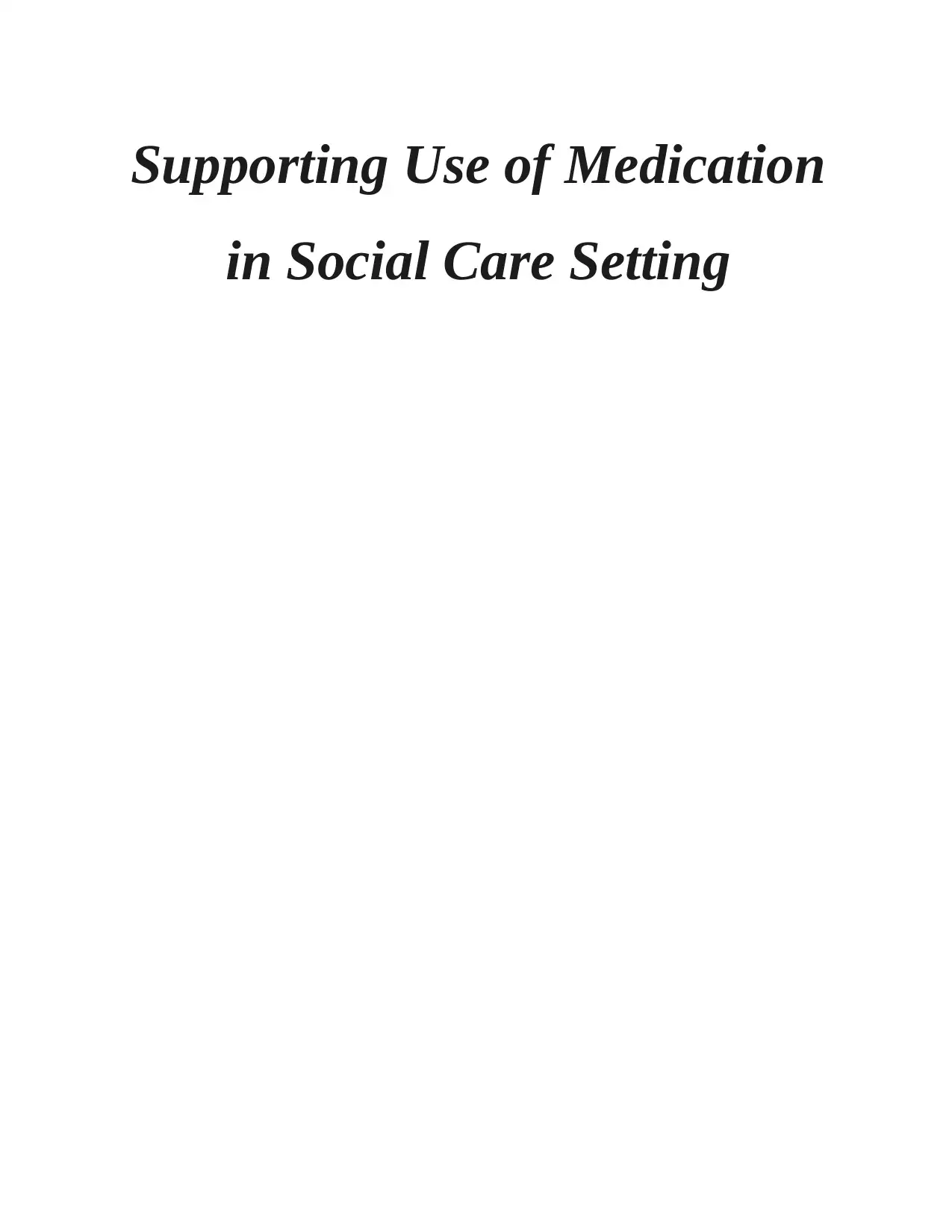
Supporting Use of Medication
in Social Care Setting
in Social Care Setting
Paraphrase This Document
Need a fresh take? Get an instant paraphrase of this document with our AI Paraphraser
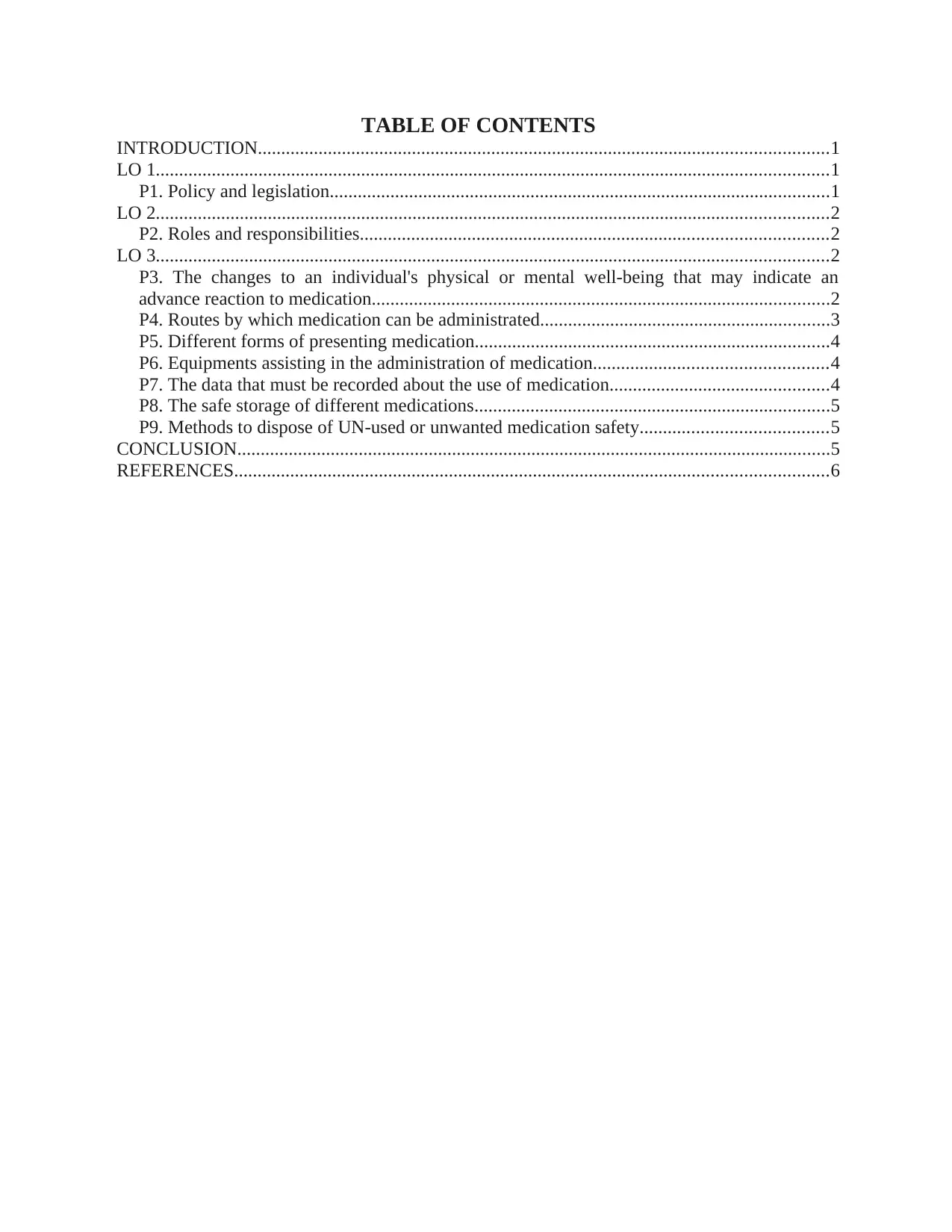
TABLE OF CONTENTS
INTRODUCTION..........................................................................................................................1
LO 1................................................................................................................................................1
P1. Policy and legislation...........................................................................................................1
LO 2................................................................................................................................................2
P2. Roles and responsibilities....................................................................................................2
LO 3................................................................................................................................................2
P3. The changes to an individual's physical or mental well-being that may indicate an
advance reaction to medication..................................................................................................2
P4. Routes by which medication can be administrated..............................................................3
P5. Different forms of presenting medication............................................................................4
P6. Equipments assisting in the administration of medication..................................................4
P7. The data that must be recorded about the use of medication...............................................4
P8. The safe storage of different medications............................................................................5
P9. Methods to dispose of UN-used or unwanted medication safety........................................5
CONCLUSION...............................................................................................................................5
REFERENCES...............................................................................................................................6
INTRODUCTION..........................................................................................................................1
LO 1................................................................................................................................................1
P1. Policy and legislation...........................................................................................................1
LO 2................................................................................................................................................2
P2. Roles and responsibilities....................................................................................................2
LO 3................................................................................................................................................2
P3. The changes to an individual's physical or mental well-being that may indicate an
advance reaction to medication..................................................................................................2
P4. Routes by which medication can be administrated..............................................................3
P5. Different forms of presenting medication............................................................................4
P6. Equipments assisting in the administration of medication..................................................4
P7. The data that must be recorded about the use of medication...............................................4
P8. The safe storage of different medications............................................................................5
P9. Methods to dispose of UN-used or unwanted medication safety........................................5
CONCLUSION...............................................................................................................................5
REFERENCES...............................................................................................................................6
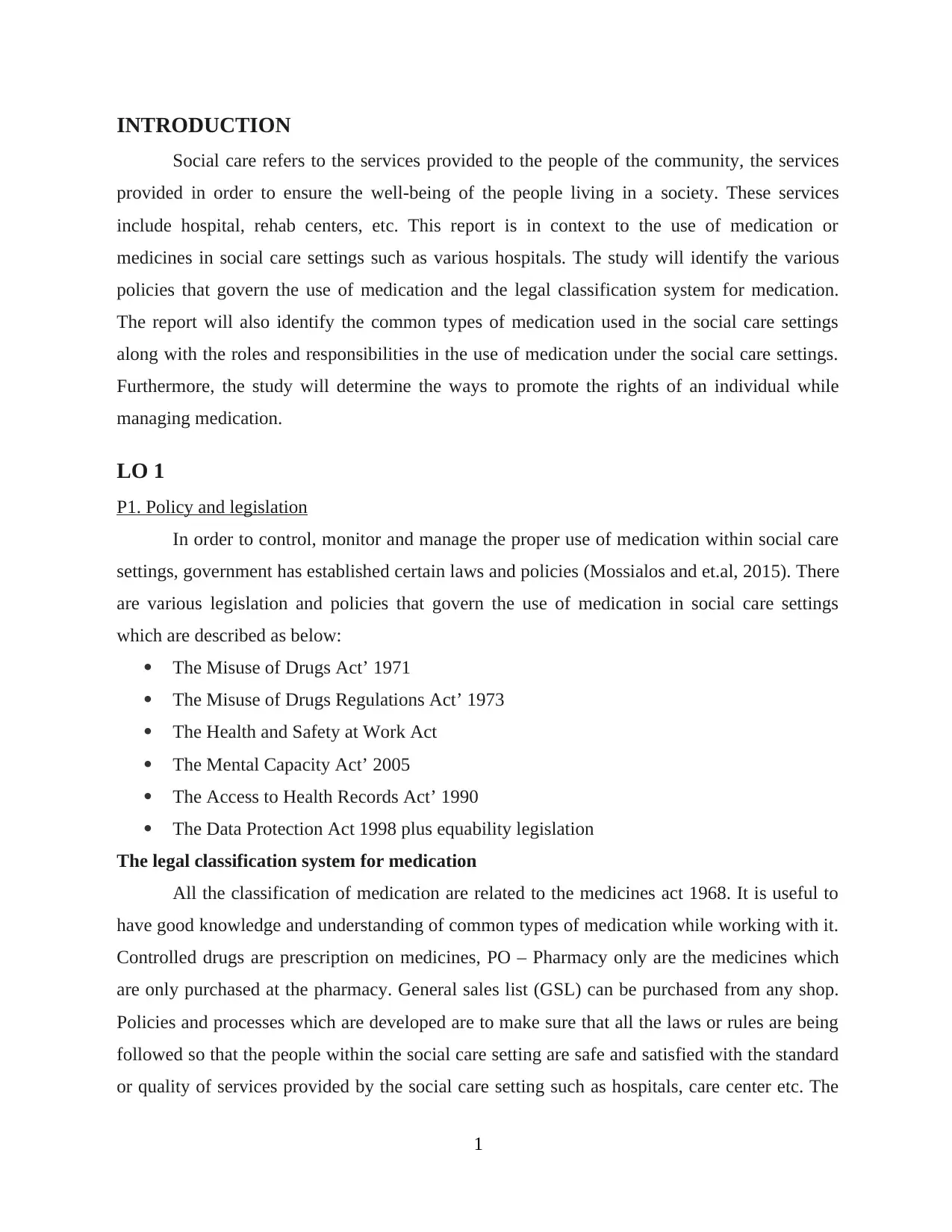
INTRODUCTION
Social care refers to the services provided to the people of the community, the services
provided in order to ensure the well-being of the people living in a society. These services
include hospital, rehab centers, etc. This report is in context to the use of medication or
medicines in social care settings such as various hospitals. The study will identify the various
policies that govern the use of medication and the legal classification system for medication.
The report will also identify the common types of medication used in the social care settings
along with the roles and responsibilities in the use of medication under the social care settings.
Furthermore, the study will determine the ways to promote the rights of an individual while
managing medication.
LO 1
P1. Policy and legislation
In order to control, monitor and manage the proper use of medication within social care
settings, government has established certain laws and policies (Mossialos and et.al, 2015). There
are various legislation and policies that govern the use of medication in social care settings
which are described as below:
The Misuse of Drugs Act’ 1971
The Misuse of Drugs Regulations Act’ 1973
The Health and Safety at Work Act
The Mental Capacity Act’ 2005
The Access to Health Records Act’ 1990
The Data Protection Act 1998 plus equability legislation
The legal classification system for medication
All the classification of medication are related to the medicines act 1968. It is useful to
have good knowledge and understanding of common types of medication while working with it.
Controlled drugs are prescription on medicines, PO – Pharmacy only are the medicines which
are only purchased at the pharmacy. General sales list (GSL) can be purchased from any shop.
Policies and processes which are developed are to make sure that all the laws or rules are being
followed so that the people within the social care setting are safe and satisfied with the standard
or quality of services provided by the social care setting such as hospitals, care center etc. The
1
Social care refers to the services provided to the people of the community, the services
provided in order to ensure the well-being of the people living in a society. These services
include hospital, rehab centers, etc. This report is in context to the use of medication or
medicines in social care settings such as various hospitals. The study will identify the various
policies that govern the use of medication and the legal classification system for medication.
The report will also identify the common types of medication used in the social care settings
along with the roles and responsibilities in the use of medication under the social care settings.
Furthermore, the study will determine the ways to promote the rights of an individual while
managing medication.
LO 1
P1. Policy and legislation
In order to control, monitor and manage the proper use of medication within social care
settings, government has established certain laws and policies (Mossialos and et.al, 2015). There
are various legislation and policies that govern the use of medication in social care settings
which are described as below:
The Misuse of Drugs Act’ 1971
The Misuse of Drugs Regulations Act’ 1973
The Health and Safety at Work Act
The Mental Capacity Act’ 2005
The Access to Health Records Act’ 1990
The Data Protection Act 1998 plus equability legislation
The legal classification system for medication
All the classification of medication are related to the medicines act 1968. It is useful to
have good knowledge and understanding of common types of medication while working with it.
Controlled drugs are prescription on medicines, PO – Pharmacy only are the medicines which
are only purchased at the pharmacy. General sales list (GSL) can be purchased from any shop.
Policies and processes which are developed are to make sure that all the laws or rules are being
followed so that the people within the social care setting are safe and satisfied with the standard
or quality of services provided by the social care setting such as hospitals, care center etc. The
1
⊘ This is a preview!⊘
Do you want full access?
Subscribe today to unlock all pages.

Trusted by 1+ million students worldwide
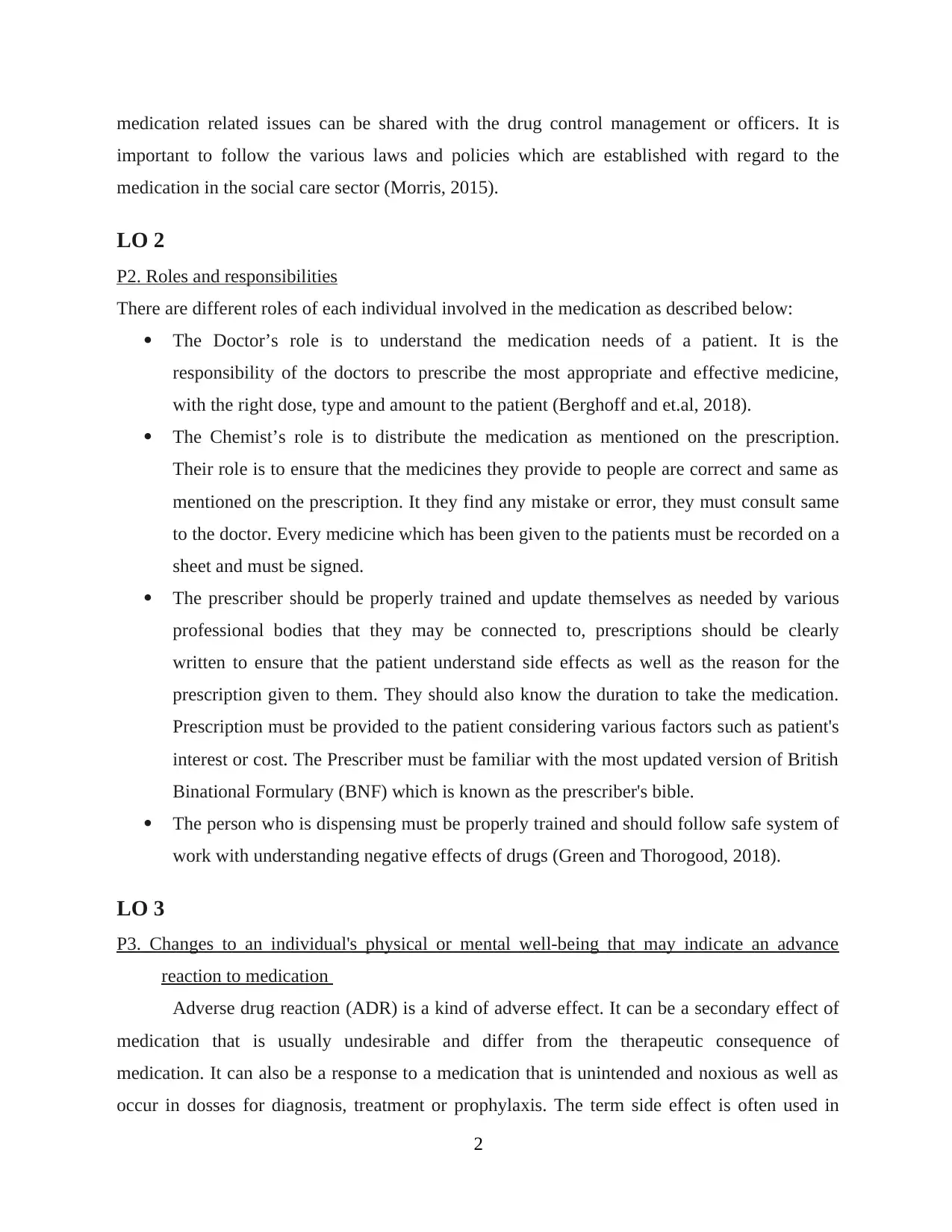
medication related issues can be shared with the drug control management or officers. It is
important to follow the various laws and policies which are established with regard to the
medication in the social care sector (Morris, 2015).
LO 2
P2. Roles and responsibilities
There are different roles of each individual involved in the medication as described below:
The Doctor’s role is to understand the medication needs of a patient. It is the
responsibility of the doctors to prescribe the most appropriate and effective medicine,
with the right dose, type and amount to the patient (Berghoff and et.al, 2018).
The Chemist’s role is to distribute the medication as mentioned on the prescription.
Their role is to ensure that the medicines they provide to people are correct and same as
mentioned on the prescription. It they find any mistake or error, they must consult same
to the doctor. Every medicine which has been given to the patients must be recorded on a
sheet and must be signed.
The prescriber should be properly trained and update themselves as needed by various
professional bodies that they may be connected to, prescriptions should be clearly
written to ensure that the patient understand side effects as well as the reason for the
prescription given to them. They should also know the duration to take the medication.
Prescription must be provided to the patient considering various factors such as patient's
interest or cost. The Prescriber must be familiar with the most updated version of British
Binational Formulary (BNF) which is known as the prescriber's bible.
The person who is dispensing must be properly trained and should follow safe system of
work with understanding negative effects of drugs (Green and Thorogood, 2018).
LO 3
P3. Changes to an individual's physical or mental well-being that may indicate an advance
reaction to medication
Adverse drug reaction (ADR) is a kind of adverse effect. It can be a secondary effect of
medication that is usually undesirable and differ from the therapeutic consequence of
medication. It can also be a response to a medication that is unintended and noxious as well as
occur in dosses for diagnosis, treatment or prophylaxis. The term side effect is often used in
2
important to follow the various laws and policies which are established with regard to the
medication in the social care sector (Morris, 2015).
LO 2
P2. Roles and responsibilities
There are different roles of each individual involved in the medication as described below:
The Doctor’s role is to understand the medication needs of a patient. It is the
responsibility of the doctors to prescribe the most appropriate and effective medicine,
with the right dose, type and amount to the patient (Berghoff and et.al, 2018).
The Chemist’s role is to distribute the medication as mentioned on the prescription.
Their role is to ensure that the medicines they provide to people are correct and same as
mentioned on the prescription. It they find any mistake or error, they must consult same
to the doctor. Every medicine which has been given to the patients must be recorded on a
sheet and must be signed.
The prescriber should be properly trained and update themselves as needed by various
professional bodies that they may be connected to, prescriptions should be clearly
written to ensure that the patient understand side effects as well as the reason for the
prescription given to them. They should also know the duration to take the medication.
Prescription must be provided to the patient considering various factors such as patient's
interest or cost. The Prescriber must be familiar with the most updated version of British
Binational Formulary (BNF) which is known as the prescriber's bible.
The person who is dispensing must be properly trained and should follow safe system of
work with understanding negative effects of drugs (Green and Thorogood, 2018).
LO 3
P3. Changes to an individual's physical or mental well-being that may indicate an advance
reaction to medication
Adverse drug reaction (ADR) is a kind of adverse effect. It can be a secondary effect of
medication that is usually undesirable and differ from the therapeutic consequence of
medication. It can also be a response to a medication that is unintended and noxious as well as
occur in dosses for diagnosis, treatment or prophylaxis. The term side effect is often used in
2
Paraphrase This Document
Need a fresh take? Get an instant paraphrase of this document with our AI Paraphraser
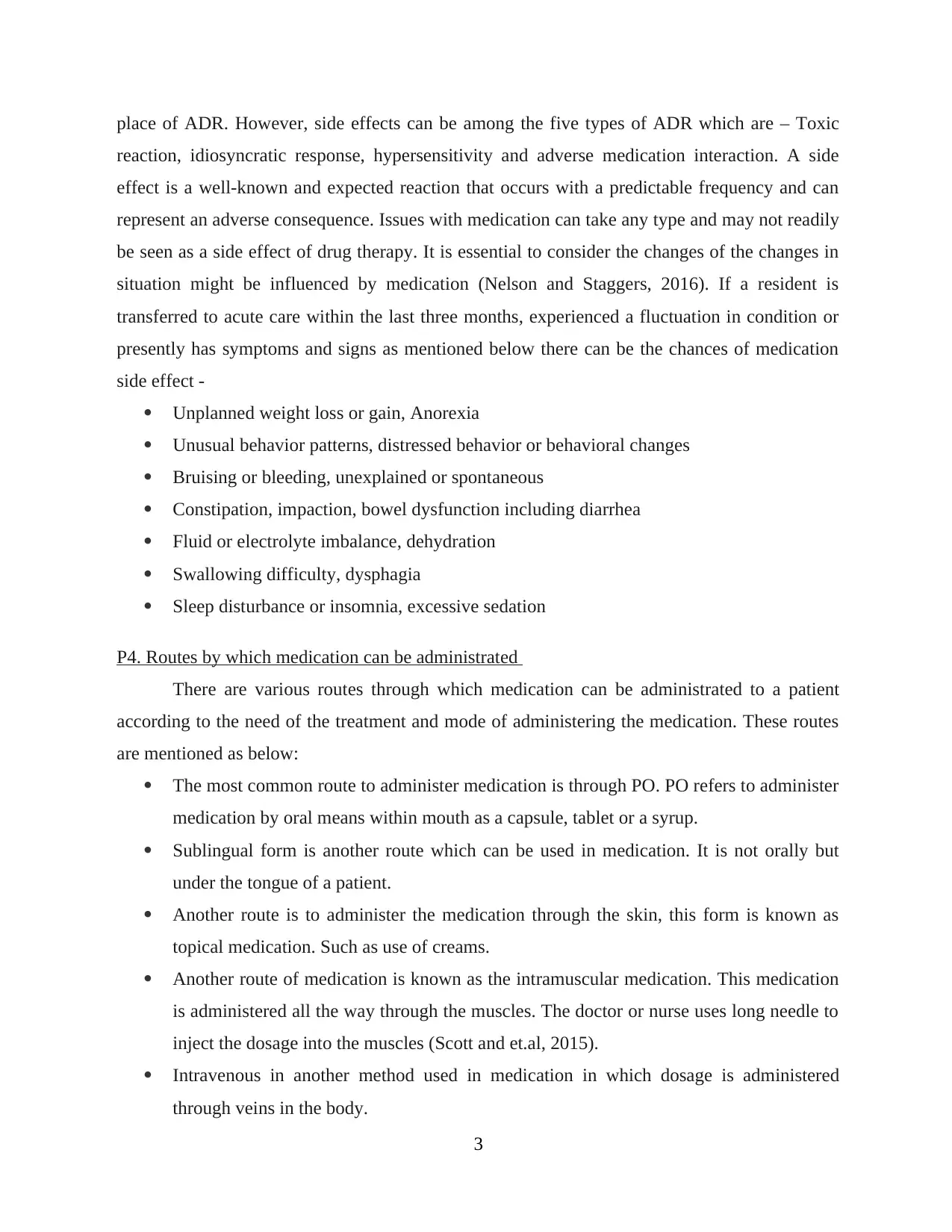
place of ADR. However, side effects can be among the five types of ADR which are – Toxic
reaction, idiosyncratic response, hypersensitivity and adverse medication interaction. A side
effect is a well-known and expected reaction that occurs with a predictable frequency and can
represent an adverse consequence. Issues with medication can take any type and may not readily
be seen as a side effect of drug therapy. It is essential to consider the changes of the changes in
situation might be influenced by medication (Nelson and Staggers, 2016). If a resident is
transferred to acute care within the last three months, experienced a fluctuation in condition or
presently has symptoms and signs as mentioned below there can be the chances of medication
side effect -
Unplanned weight loss or gain, Anorexia
Unusual behavior patterns, distressed behavior or behavioral changes
Bruising or bleeding, unexplained or spontaneous
Constipation, impaction, bowel dysfunction including diarrhea
Fluid or electrolyte imbalance, dehydration
Swallowing difficulty, dysphagia
Sleep disturbance or insomnia, excessive sedation
P4. Routes by which medication can be administrated
There are various routes through which medication can be administrated to a patient
according to the need of the treatment and mode of administering the medication. These routes
are mentioned as below:
The most common route to administer medication is through PO. PO refers to administer
medication by oral means within mouth as a capsule, tablet or a syrup.
Sublingual form is another route which can be used in medication. It is not orally but
under the tongue of a patient.
Another route is to administer the medication through the skin, this form is known as
topical medication. Such as use of creams.
Another route of medication is known as the intramuscular medication. This medication
is administered all the way through the muscles. The doctor or nurse uses long needle to
inject the dosage into the muscles (Scott and et.al, 2015).
Intravenous in another method used in medication in which dosage is administered
through veins in the body.
3
reaction, idiosyncratic response, hypersensitivity and adverse medication interaction. A side
effect is a well-known and expected reaction that occurs with a predictable frequency and can
represent an adverse consequence. Issues with medication can take any type and may not readily
be seen as a side effect of drug therapy. It is essential to consider the changes of the changes in
situation might be influenced by medication (Nelson and Staggers, 2016). If a resident is
transferred to acute care within the last three months, experienced a fluctuation in condition or
presently has symptoms and signs as mentioned below there can be the chances of medication
side effect -
Unplanned weight loss or gain, Anorexia
Unusual behavior patterns, distressed behavior or behavioral changes
Bruising or bleeding, unexplained or spontaneous
Constipation, impaction, bowel dysfunction including diarrhea
Fluid or electrolyte imbalance, dehydration
Swallowing difficulty, dysphagia
Sleep disturbance or insomnia, excessive sedation
P4. Routes by which medication can be administrated
There are various routes through which medication can be administrated to a patient
according to the need of the treatment and mode of administering the medication. These routes
are mentioned as below:
The most common route to administer medication is through PO. PO refers to administer
medication by oral means within mouth as a capsule, tablet or a syrup.
Sublingual form is another route which can be used in medication. It is not orally but
under the tongue of a patient.
Another route is to administer the medication through the skin, this form is known as
topical medication. Such as use of creams.
Another route of medication is known as the intramuscular medication. This medication
is administered all the way through the muscles. The doctor or nurse uses long needle to
inject the dosage into the muscles (Scott and et.al, 2015).
Intravenous in another method used in medication in which dosage is administered
through veins in the body.
3
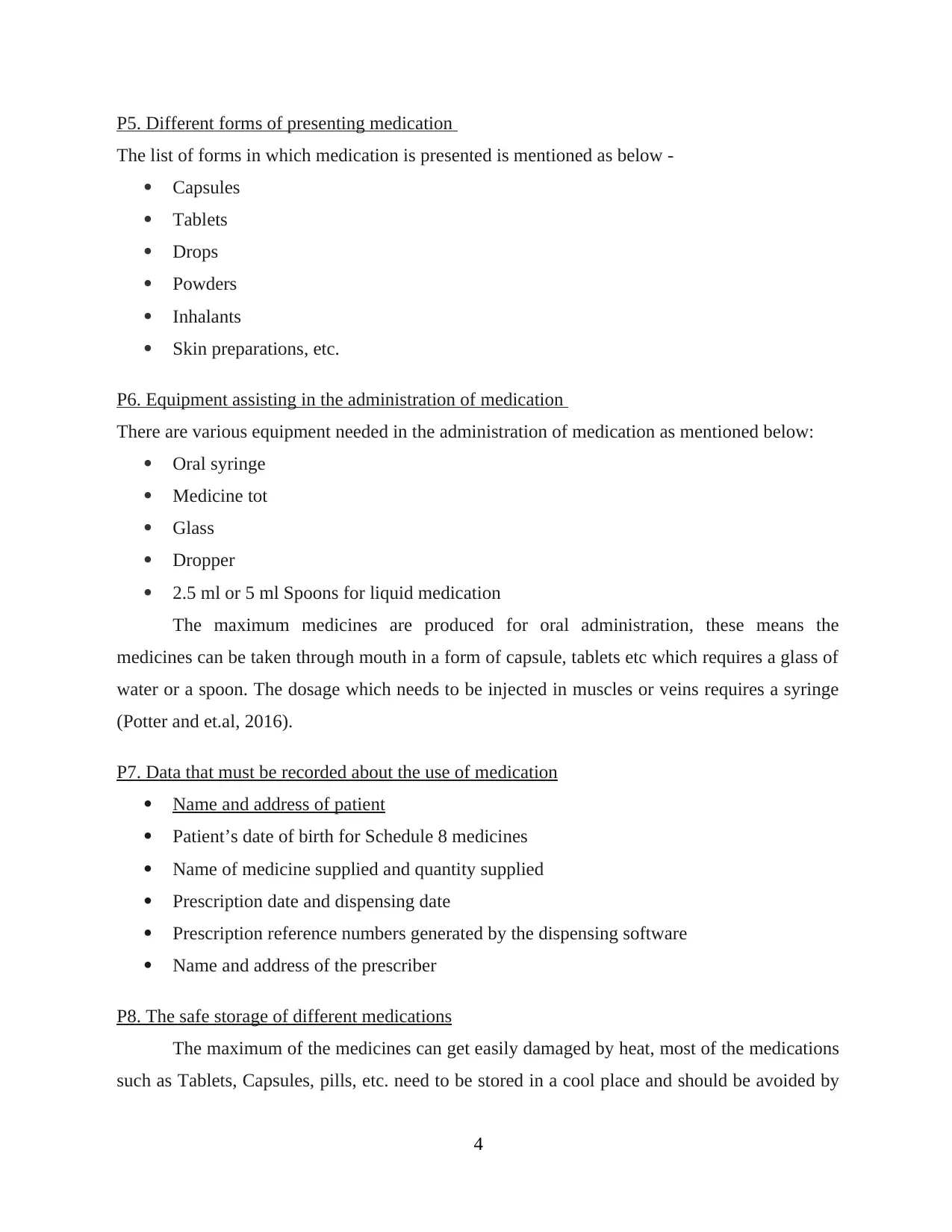
P5. Different forms of presenting medication
The list of forms in which medication is presented is mentioned as below -
Capsules
Tablets
Drops
Powders
Inhalants
Skin preparations, etc.
P6. Equipment assisting in the administration of medication
There are various equipment needed in the administration of medication as mentioned below:
Oral syringe
Medicine tot
Glass
Dropper
2.5 ml or 5 ml Spoons for liquid medication
The maximum medicines are produced for oral administration, these means the
medicines can be taken through mouth in a form of capsule, tablets etc which requires a glass of
water or a spoon. The dosage which needs to be injected in muscles or veins requires a syringe
(Potter and et.al, 2016).
P7. Data that must be recorded about the use of medication
Name and address of patient
Patient’s date of birth for Schedule 8 medicines
Name of medicine supplied and quantity supplied
Prescription date and dispensing date
Prescription reference numbers generated by the dispensing software
Name and address of the prescriber
P8. The safe storage of different medications
The maximum of the medicines can get easily damaged by heat, most of the medications
such as Tablets, Capsules, pills, etc. need to be stored in a cool place and should be avoided by
4
The list of forms in which medication is presented is mentioned as below -
Capsules
Tablets
Drops
Powders
Inhalants
Skin preparations, etc.
P6. Equipment assisting in the administration of medication
There are various equipment needed in the administration of medication as mentioned below:
Oral syringe
Medicine tot
Glass
Dropper
2.5 ml or 5 ml Spoons for liquid medication
The maximum medicines are produced for oral administration, these means the
medicines can be taken through mouth in a form of capsule, tablets etc which requires a glass of
water or a spoon. The dosage which needs to be injected in muscles or veins requires a syringe
(Potter and et.al, 2016).
P7. Data that must be recorded about the use of medication
Name and address of patient
Patient’s date of birth for Schedule 8 medicines
Name of medicine supplied and quantity supplied
Prescription date and dispensing date
Prescription reference numbers generated by the dispensing software
Name and address of the prescriber
P8. The safe storage of different medications
The maximum of the medicines can get easily damaged by heat, most of the medications
such as Tablets, Capsules, pills, etc. need to be stored in a cool place and should be avoided by
4
⊘ This is a preview!⊘
Do you want full access?
Subscribe today to unlock all pages.

Trusted by 1+ million students worldwide
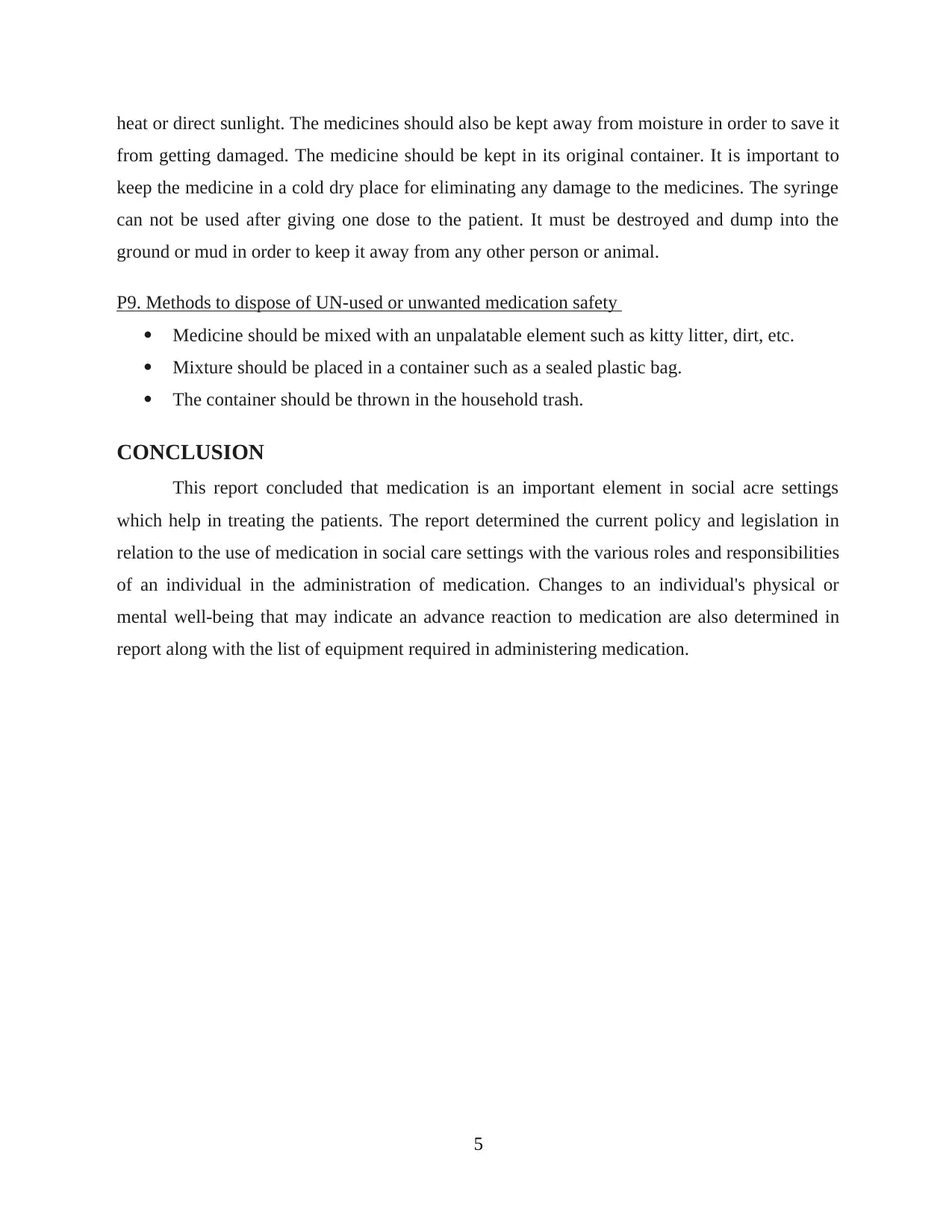
heat or direct sunlight. The medicines should also be kept away from moisture in order to save it
from getting damaged. The medicine should be kept in its original container. It is important to
keep the medicine in a cold dry place for eliminating any damage to the medicines. The syringe
can not be used after giving one dose to the patient. It must be destroyed and dump into the
ground or mud in order to keep it away from any other person or animal.
P9. Methods to dispose of UN-used or unwanted medication safety
Medicine should be mixed with an unpalatable element such as kitty litter, dirt, etc.
Mixture should be placed in a container such as a sealed plastic bag.
The container should be thrown in the household trash.
CONCLUSION
This report concluded that medication is an important element in social acre settings
which help in treating the patients. The report determined the current policy and legislation in
relation to the use of medication in social care settings with the various roles and responsibilities
of an individual in the administration of medication. Changes to an individual's physical or
mental well-being that may indicate an advance reaction to medication are also determined in
report along with the list of equipment required in administering medication.
5
from getting damaged. The medicine should be kept in its original container. It is important to
keep the medicine in a cold dry place for eliminating any damage to the medicines. The syringe
can not be used after giving one dose to the patient. It must be destroyed and dump into the
ground or mud in order to keep it away from any other person or animal.
P9. Methods to dispose of UN-used or unwanted medication safety
Medicine should be mixed with an unpalatable element such as kitty litter, dirt, etc.
Mixture should be placed in a container such as a sealed plastic bag.
The container should be thrown in the household trash.
CONCLUSION
This report concluded that medication is an important element in social acre settings
which help in treating the patients. The report determined the current policy and legislation in
relation to the use of medication in social care settings with the various roles and responsibilities
of an individual in the administration of medication. Changes to an individual's physical or
mental well-being that may indicate an advance reaction to medication are also determined in
report along with the list of equipment required in administering medication.
5
Paraphrase This Document
Need a fresh take? Get an instant paraphrase of this document with our AI Paraphraser
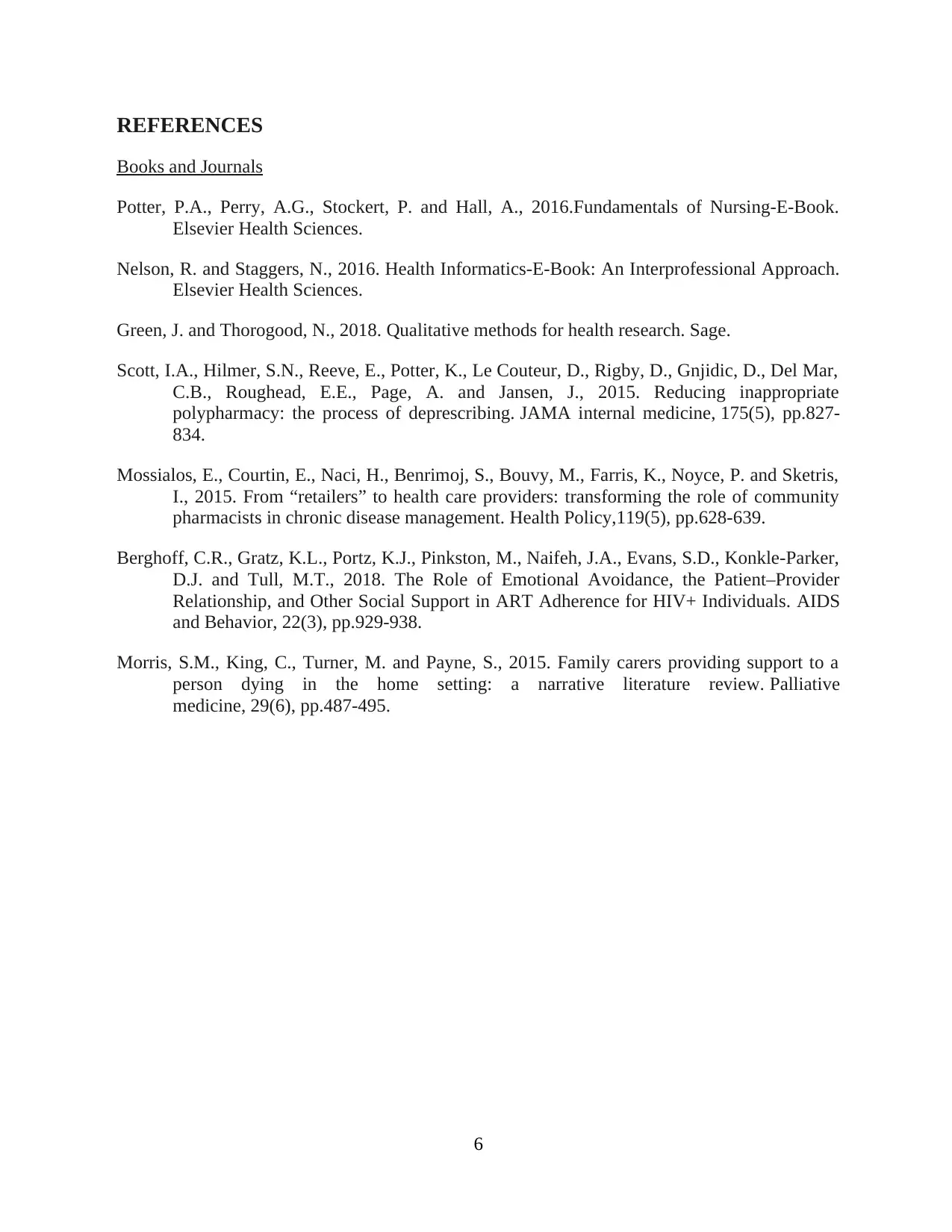
REFERENCES
Books and Journals
Potter, P.A., Perry, A.G., Stockert, P. and Hall, A., 2016.Fundamentals of Nursing-E-Book.
Elsevier Health Sciences.
Nelson, R. and Staggers, N., 2016. Health Informatics-E-Book: An Interprofessional Approach.
Elsevier Health Sciences.
Green, J. and Thorogood, N., 2018. Qualitative methods for health research. Sage.
Scott, I.A., Hilmer, S.N., Reeve, E., Potter, K., Le Couteur, D., Rigby, D., Gnjidic, D., Del Mar,
C.B., Roughead, E.E., Page, A. and Jansen, J., 2015. Reducing inappropriate
polypharmacy: the process of deprescribing. JAMA internal medicine, 175(5), pp.827-
834.
Mossialos, E., Courtin, E., Naci, H., Benrimoj, S., Bouvy, M., Farris, K., Noyce, P. and Sketris,
I., 2015. From “retailers” to health care providers: transforming the role of community
pharmacists in chronic disease management. Health Policy,119(5), pp.628-639.
Berghoff, C.R., Gratz, K.L., Portz, K.J., Pinkston, M., Naifeh, J.A., Evans, S.D., Konkle-Parker,
D.J. and Tull, M.T., 2018. The Role of Emotional Avoidance, the Patient–Provider
Relationship, and Other Social Support in ART Adherence for HIV+ Individuals. AIDS
and Behavior, 22(3), pp.929-938.
Morris, S.M., King, C., Turner, M. and Payne, S., 2015. Family carers providing support to a
person dying in the home setting: a narrative literature review. Palliative
medicine, 29(6), pp.487-495.
6
Books and Journals
Potter, P.A., Perry, A.G., Stockert, P. and Hall, A., 2016.Fundamentals of Nursing-E-Book.
Elsevier Health Sciences.
Nelson, R. and Staggers, N., 2016. Health Informatics-E-Book: An Interprofessional Approach.
Elsevier Health Sciences.
Green, J. and Thorogood, N., 2018. Qualitative methods for health research. Sage.
Scott, I.A., Hilmer, S.N., Reeve, E., Potter, K., Le Couteur, D., Rigby, D., Gnjidic, D., Del Mar,
C.B., Roughead, E.E., Page, A. and Jansen, J., 2015. Reducing inappropriate
polypharmacy: the process of deprescribing. JAMA internal medicine, 175(5), pp.827-
834.
Mossialos, E., Courtin, E., Naci, H., Benrimoj, S., Bouvy, M., Farris, K., Noyce, P. and Sketris,
I., 2015. From “retailers” to health care providers: transforming the role of community
pharmacists in chronic disease management. Health Policy,119(5), pp.628-639.
Berghoff, C.R., Gratz, K.L., Portz, K.J., Pinkston, M., Naifeh, J.A., Evans, S.D., Konkle-Parker,
D.J. and Tull, M.T., 2018. The Role of Emotional Avoidance, the Patient–Provider
Relationship, and Other Social Support in ART Adherence for HIV+ Individuals. AIDS
and Behavior, 22(3), pp.929-938.
Morris, S.M., King, C., Turner, M. and Payne, S., 2015. Family carers providing support to a
person dying in the home setting: a narrative literature review. Palliative
medicine, 29(6), pp.487-495.
6
1 out of 8
Related Documents
Your All-in-One AI-Powered Toolkit for Academic Success.
+13062052269
info@desklib.com
Available 24*7 on WhatsApp / Email
![[object Object]](/_next/static/media/star-bottom.7253800d.svg)
Unlock your academic potential
Copyright © 2020–2025 A2Z Services. All Rights Reserved. Developed and managed by ZUCOL.





